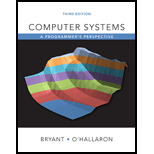
Computer Systems: A Programmer's Perspective (3rd Edition)
3rd Edition
ISBN: 9780134092669
Author: Bryant, Randal E. Bryant, David R. O'Hallaron, David R., Randal E.; O'Hallaron, Bryant/O'hallaron
Publisher: PEARSON
expand_more
expand_more
format_list_bulleted
Question
Chapter 12, Problem 12.33HW
Program Plan Intro
I/O Multiplexing:
- The idea of I/O multiplexing is to use “select” function to ask kernel to suspend process.
- It returns control to application only after one or more I/O events had occurred.
- It denotes waiting for a set of descriptors that is ready for reading.
- The “select” function would manipulate sets of type “fd_set”, that denotes descriptor sets.
- It takes two inputs: a descriptor set called “read set” and cardinality of read set.
- It blocks until at least one descriptor in read set is ready for reading.
- A descriptor “k” is ready for reading if and only if a request to read 1 byte from that descriptor would not block.
- The “fd_set” is been modified that points to argument “fdset” to indicate subset of read set called “ready set”.
- The value returned by function indicates cardinality of ready set.
Expert Solution & Answer
Want to see the full answer?
Check out a sample textbook solution
Students have asked these similar questions
Hello please look at the attached picture. I need an detailed explanation of the architecture
Information Security Risk and Vulnerability Assessment
1- Which TCP/IP protocol is used to convert the IP address to the Mac address? Explain 2-What popular switch feature allows you to create communication boundaries between systems connected to the switch3- what types of vulnerability directly related to the programmer of the software?4- Who ensures the entity implements appropriate security controls to protect an asset?
Please do not use AI and add refrence
Find the voltage V0 across the 4K resistor using the mesh method or nodal analysis. Note: I have already simulated it and the value it should give is -1.714V
Chapter 12 Solutions
Computer Systems: A Programmer's Perspective (3rd Edition)
Ch. 12.1 - Prob. 12.1PPCh. 12.1 - Prob. 12.2PPCh. 12.2 - Practice Problem 12.3 (solution page 1036) In...Ch. 12.2 - Practice Problem 12.4 (solution page 1036) In the...Ch. 12.4 - Prob. 12.5PPCh. 12.4 - Prob. 12.6PPCh. 12.5 - Prob. 12.7PPCh. 12.5 - Prob. 12.8PPCh. 12.5 - Prob. 12.9PPCh. 12.5 - Prob. 12.10PP
Ch. 12.6 - Prob. 12.11PPCh. 12.7 - Prob. 12.12PPCh. 12.7 - Prob. 12.13PPCh. 12.7 - Prob. 12.14PPCh. 12.7 - Prob. 12.15PPCh. 12 - Prob. 12.20HWCh. 12 - Derive a solution to the second readers-writers...Ch. 12 - Prob. 12.22HWCh. 12 - Prob. 12.23HWCh. 12 - Prob. 12.24HWCh. 12 - Prob. 12.25HWCh. 12 - Prob. 12.26HWCh. 12 - Some network programming texts suggest the...Ch. 12 - Prob. 12.28HWCh. 12 - Prob. 12.29HWCh. 12 - Prob. 12.30HWCh. 12 - Implement a version of the standard I/O fgets...Ch. 12 - Prob. 12.32HWCh. 12 - Prob. 12.33HWCh. 12 - Prob. 12.34HWCh. 12 - Prob. 12.35HWCh. 12 - Prob. 12.36HWCh. 12 - Prob. 12.37HWCh. 12 - Prob. 12.38HWCh. 12 - Prob. 12.39HW
Knowledge Booster
Similar questions
- Briefly describe the issues involved in using ATM technology in Local Area Networksarrow_forwardFor this question you will perform two levels of quicksort on an array containing these numbers: 59 41 61 73 43 57 50 13 96 88 42 77 27 95 32 89 In the first blank, enter the array contents after the top level partition. In the second blank, enter the array contents after one more partition of the left-hand subarray resulting from the first partition. In the third blank, enter the array contents after one more partition of the right-hand subarray resulting from the first partition. Print the numbers with a single space between them. Use the algorithm we covered in class, in which the first element of the subarray is the partition value. Question 1 options: Blank # 1 Blank # 2 Blank # 3arrow_forward1. Transform the E-R diagram into a set of relations. Country_of Agent ID Agent H Holds Is_Reponsible_for Consignment Number $ Value May Contain Consignment Transports Container Destination Ф R Goes Off Container Number Size Vessel Voyage Registry Vessel ID Voyage_ID Tonnagearrow_forward
- I want to solve 13.2 using matlab please helparrow_forwarda) Show a possible trace of the OSPF algorithm for computing the routing table in Router 2 forthis network.b) Show the messages used by RIP to compute routing tables.arrow_forwardusing r language to answer question 4 Question 4: Obtain a 95% standard normal bootstrap confidence interval, a 95% basic bootstrap confidence interval, and a percentile confidence interval for the ρb12 in Question 3.arrow_forward
arrow_back_ios
SEE MORE QUESTIONS
arrow_forward_ios
Recommended textbooks for you
 C++ Programming: From Problem Analysis to Program...Computer ScienceISBN:9781337102087Author:D. S. MalikPublisher:Cengage Learning
C++ Programming: From Problem Analysis to Program...Computer ScienceISBN:9781337102087Author:D. S. MalikPublisher:Cengage Learning C++ for Engineers and ScientistsComputer ScienceISBN:9781133187844Author:Bronson, Gary J.Publisher:Course Technology Ptr
C++ for Engineers and ScientistsComputer ScienceISBN:9781133187844Author:Bronson, Gary J.Publisher:Course Technology Ptr EBK JAVA PROGRAMMINGComputer ScienceISBN:9781305480537Author:FARRELLPublisher:CENGAGE LEARNING - CONSIGNMENT
EBK JAVA PROGRAMMINGComputer ScienceISBN:9781305480537Author:FARRELLPublisher:CENGAGE LEARNING - CONSIGNMENT New Perspectives on HTML5, CSS3, and JavaScriptComputer ScienceISBN:9781305503922Author:Patrick M. CareyPublisher:Cengage Learning
New Perspectives on HTML5, CSS3, and JavaScriptComputer ScienceISBN:9781305503922Author:Patrick M. CareyPublisher:Cengage Learning Systems ArchitectureComputer ScienceISBN:9781305080195Author:Stephen D. BurdPublisher:Cengage Learning
Systems ArchitectureComputer ScienceISBN:9781305080195Author:Stephen D. BurdPublisher:Cengage Learning Operations Research : Applications and AlgorithmsComputer ScienceISBN:9780534380588Author:Wayne L. WinstonPublisher:Brooks Cole
Operations Research : Applications and AlgorithmsComputer ScienceISBN:9780534380588Author:Wayne L. WinstonPublisher:Brooks Cole

C++ Programming: From Problem Analysis to Program...
Computer Science
ISBN:9781337102087
Author:D. S. Malik
Publisher:Cengage Learning

C++ for Engineers and Scientists
Computer Science
ISBN:9781133187844
Author:Bronson, Gary J.
Publisher:Course Technology Ptr

EBK JAVA PROGRAMMING
Computer Science
ISBN:9781305480537
Author:FARRELL
Publisher:CENGAGE LEARNING - CONSIGNMENT

New Perspectives on HTML5, CSS3, and JavaScript
Computer Science
ISBN:9781305503922
Author:Patrick M. Carey
Publisher:Cengage Learning

Systems Architecture
Computer Science
ISBN:9781305080195
Author:Stephen D. Burd
Publisher:Cengage Learning

Operations Research : Applications and Algorithms
Computer Science
ISBN:9780534380588
Author:Wayne L. Winston
Publisher:Brooks Cole